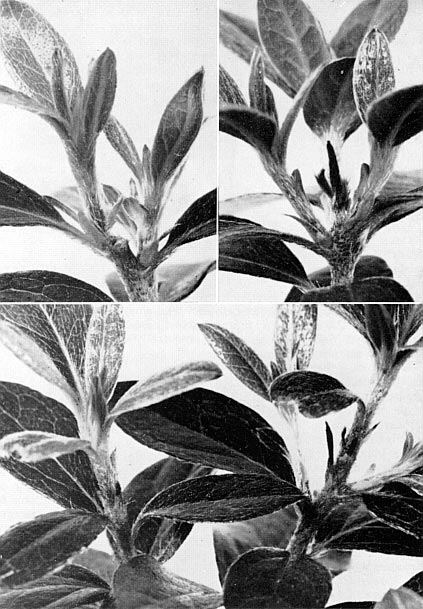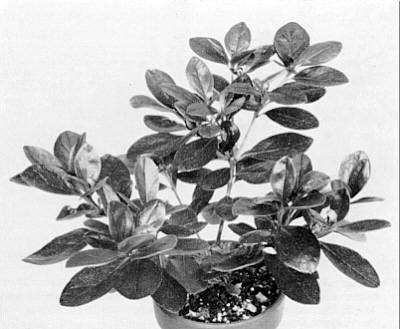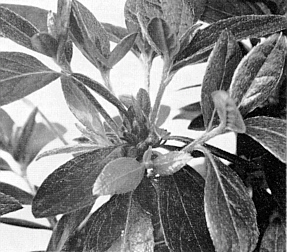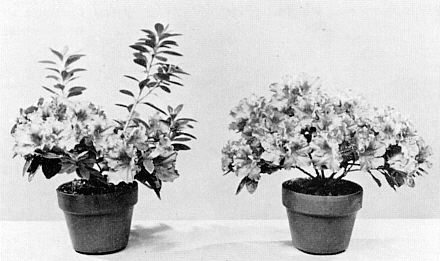QBARS - v21n3 Chemical Pruning of Greenhouse Azaleas with Fatty Acid Esters
Chemical Pruning Of Greenhouse Azaleas With Fatty Acid Esters
Neil W. Stuart
Physiologist, Crops Research Division
Agricultural Research Service, U.S. Department of Agriculture, Beltsville, Maryland
This article is released for publication under the terms of the memorandum of agreement between the Society of American Florists and the USDA .
Spraying azaleas with suitably emulsified fatty acid esters will effectively prune them by killing the shoot tips without injuring the rest of the plant. This action is based on an observation made o 3 that certain fatty acid esters prevented the growth of axillary buds when applied to tobacco plants whose tops had been removed. His objective was sucker control.
While testing disbudding agents on standard chrysanthemums, Cathey 2 found that spraying intact, vegetative plants with the emulsions used o killed the terminal growing points without injuring the axillary buds which later developed into normal shoots. Thus the chemicals in effect pinched or pruned the plants. We now know that many other kinds of plants, including azaleas, respond in the same manner as the chrysanthemum. 1

|
|
Fig. 52. Azalea cultivar 'Red Wing'. Top left: shoot pruned
manually, March 31, 1967. Top right: shoot sprayed with 5 percent C 8 -C 10 methyl ester-polysorbate-20 March 32. Bottom: shoots sprayed with 3 percent C 8 -C 10 methyl ester-poly-sorbate-20 emulsion March 31. Photo May 9, 1967 |

|
|
Fig. 53. Azalea cultivar 'Ablaze'. Propagated September
16, 1966, potted November 2, sprayed with 4 percent C 9 methyl ester-polysorbate-20, January 25, March 13, and April 24. Photo May 9, 1967. |

|
|
Fig. 54. Azalea cultivar 'Red Wing'. Budded
plant sprayed with 5 percent C 8 -C 10 methyl ester-polysorbate-20 emulsion. March 31, 1967. |

|
|
Fig. 55. Azalea cultivar 'Red Wing'. Left plant pruned manually
March 25, 1966. Right: plant sprayed with 5 percent methyl ester-poly-sorbate-20 emulsion March 25. Both plants stored at 50° July 8, returned to greenhouse September 9. Photo Oct. 21, 1966. |
Preparing and Applying Emulsion Sprays for Pruning Azaleas
What they are. The fatty acids (so called because they result when fats are broken down) form a regular series of simple compounds containing carbon, hydrogen, and oxygen. They range from the familiar acetic acid of vinegar to the long chained (more carbon atoms) fatty acids which when combined with sodium or potassium form the soaps of commerce. As the chain length increases, the acids become insoluble in water. They will react with alcohols to form esters. These in turn will dissolve in certain classes of surface active agents. When the proper combinations are chosen the resulting solutions will form stable emulsions in water which are suitable for spraying on plants. Tso, Steffens, and Englehaupt 4 found the methyl fatty acid ester from methyl (wood) alcohol to he more effective than esters from the higher (more carbon atoms) alcohols in preventing bud growth of tobacco. Tests showed that the methyl esters of fatty acids containing from 8 to 12 carbon atoms were active in pruning plants. Acids with fewer, or more, carbons were much less active or damaged the plants.
How to use them. Success with the fatty acid esters in pruning plants depends on use of the proper kind and amount of surfactant. The surfactants play many roles; (a) they permit emulsification, (b) promote penetration, and (c) prevent or reduce foliar injury. Our best formulations resulted when equal weights of fatty acid ester and surfactant were blended, then gradually diluted and mixed with water to form a stable emulsion. We have used polysorbate-20 most extensively; however, others were satisfactory, depending upon the formulations. 5
Plants to be treated should be watered and have dry leaf surfaces. The temperature at time of treatment should be above 65°F. We apply a fine spray of the emulsion until the leaves glisten and surfaces (especially shoot tips) are wetted to the point of run-off. The pruning agent penetrates rapidly in amounts sufficient to selectively kill the shoot tips. Syringing the plants with water 15 to 30 minutes after application of the emulsion will reduce leaf injury.
How much to use. The best concentration of pruning agent depends to some extent upon (a) the cultivar (variety), (b) the condition of the plants, and (c) the location and time of year.
We have consistently pruned azaleas of several cultivars chemically with emulsions containing 4 to 5 percent of the methyl esters of C 9 , C 10 , and a combination of C 8 and C 10 fatty acids, using equal amounts of surfactant, usually polysorbate-20, in all cases. 6 Lower concentrations either do not kill the shoot tips or simply retard them for a time, allowing one or more axillary shoots to develop. Fig. 52 shows a 'Red Wing' azalea plant in this condition, compared with one that was pruned with 5 percent of a mixture of C 8 and C 10 emulsion and one that was pruned manually.
The effect of higher concentrations (above 5 percent) of pruning agents is to kill more of the shoot tip, injure some of the leaves,' and delay re-growth. There may be a slight delay in axillary bud break on chemically pruned plants, but unless they are greatly over treated the new shoots make as much or more growth than shoots from sheared plants. Frequently those chemically pruned develop more shoots than the hand-pruned ones. Fig. 53 shows an 'Ablaze' azalea plant that was sprayed three times at 6-week intervals with 4 percent C 9 methyl ester emulsion. (An 8 percent emulsion of a 50/50 blend of C 9 methyl ester and polysorbate-20). This plant was never pruned manually. Frequency of chemical pruning will depend upon rate of growth. Since each "chemical pruning" removes only the growing point, and leaves the fully expanded leaves intact, the plants usually attain a standard size sooner than when hand pruned or sheared.
Tests showed that azalea flower buds are easily killed by suitable concentrations of fatty acid ester emulsion sprays. Fig. 54 shows a 'Red Wing' azalea plant with fully developed flower buds at time of treatment, 39 days after spraying with 5 percent C 8 --C 10 fatty acid ester emulsion. All flower buds were killed without injury to the axillary buds which developed strong shoots. Thus budded liners, or other plants needing disbudding, can be restored to active growth without cold storage or hand pruning simply by spraying with the chemical pruning agents.
Effect on flowering. Action of the chemical pruning agents appears to be short-lived without undesirable carry-over effects. Fig. 55 shows a 'Red Wing' plant that was pruned manually and one that was sprayed with 5 percent C 10 fatty acid ester on March 25. Both plants developed shoots, set buds and bloomed in October following storage at 50°. Absence of wild shoots and uniformity of plant growth and bloom characterized the chemically pruned plant.
Discussion
Our preliminary trials with the fatty acid ester emulsions suggest that they will be useful in pruning azaleas of all sizes, eliminate much hand labor, and reduce the time for producing plants of acceptable size. Commercial formulations of the pruning agents will probably soon be available following preliminary testing around the country. We urge prospective users to wait for these commercial preparations rather than attempt to prepare their own unless all precautions in formulation are observed. We also urge that your initial evaluation be on a trial basis. Follow the manufacturers' directions (their formulations may be slightly different from the ones reported here) and observe results under your own growing conditions. Cultivars will differ somewhat in responsiveness to the pruning agents, and any one cultivar will differ depending upon the condition of the plants as well as how and where they are grown.
Perhaps new methods of application (as by aerosol) will prove more effective and economical than sprays. New formulations and new chemical pruning agents are sure to appear. A continued testing and evaluation program will be needed. However, the results obtained thus far appear to justify this continuing effort.
Literature Cited
- Cathey, H. M., G. L. Steffens, N. W. Stuart, and R. H. Zimmerman, 1966, Chemical pruning of plants, Science, 156: (3742) 1382-1383.
- Cathey, H. M., A. H. Yoeinan, and Floyd F. Smith, 1966, Abortion of flower butts in chrysanthemum after application of a selected petroleum fraction of high aromatic content, Hort. Science, 1: (2) 61-62.
- Tso, T. C., Plant growth inhibition by some fatty acids and their analogues, Nature 202: 511.
- Tso, T. C., G. L. Steffens, and M. E. Englehaupt, 1965, Inhibition of tobacco bud growth with fatty acid methyl esters, Agr. and Food Chem., 13: 78.
- Supplied by Atlas Chemical Industries, Chemical Division, Wilmington, Del. We express appreciation for their generous cooperation.
- The C methyl ester ("Emery C-9") was furnished by Emery Industries, Inc., Organic Chemicals Div., Cincinnati. Ohio. The C 10 and C 8 -C 10 formulation ("Off-Shoot") was supplied by Procter and Gamble, Industrial Chemicals Division, Cincinnati, Ohio. The cooperation of these manufacturers has made these tests possible.
- Mention of a trade name does not constitute a guarantee or warranty of the product by the U.S. Department of Agriculture nor an endorsement by the Department over other products not mentioned.
